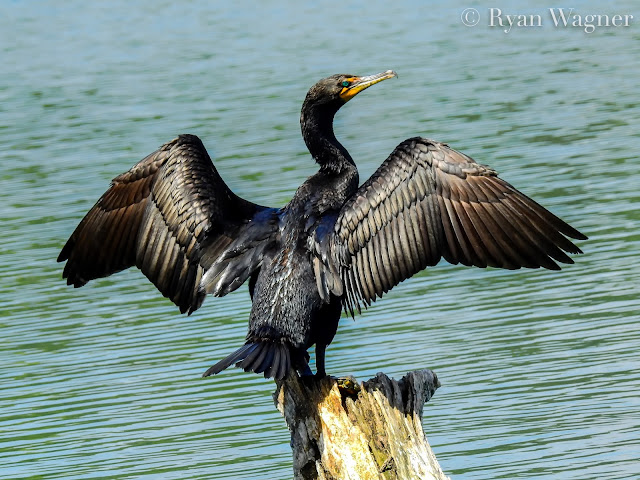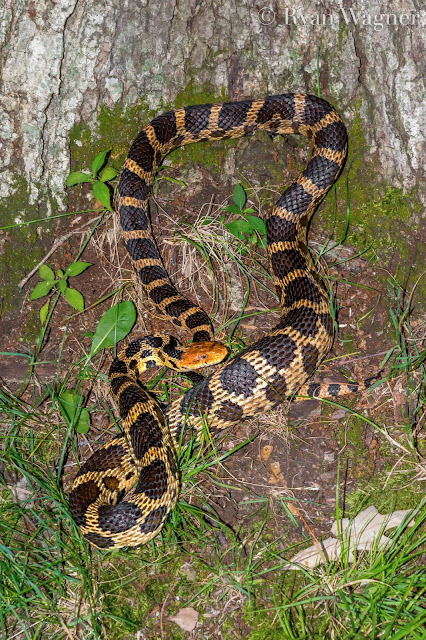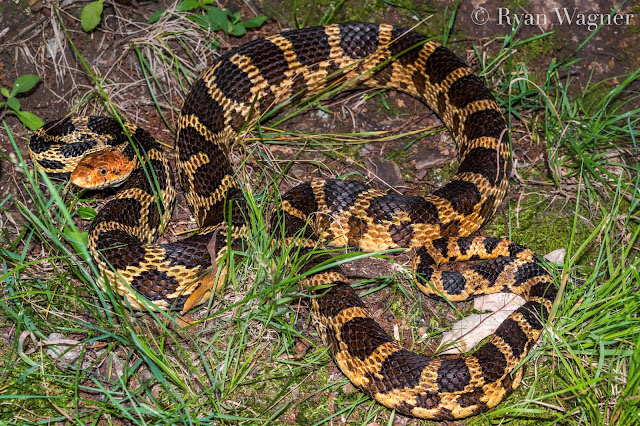On my journey to find all of Ohio’s amphibians (and everything else), I occasionally receive recommendations from other frog enthusiasts regarding new locations to search. Without the help of others who know the animals and their habitats better than I do, I would have little chance of discovering them all on my own. For anyone who has helped me or who will help me in the future, I am eternally grateful.
A double-crested cormorant drifted offshore, looking as primitive and mysterious as Loch Ness herself. She remained above the water’s surface for only moments before diving back down to hunt for fish. I watched the ripples left by the great water bird undulate slowly out of existence. Thirty seconds later, she popped up with a large catfish clutched tightly in her long, hooked bill. Before I could ready my camera, the fish disappeared down the bird’s gullet with one quick upward thrust of the neck.
Satisfied with her meal, the cormorant drifted in my direction. She stopped at a tree stump protruding like a little stage from the water and hopped up, knocking off a basking turtle in the process. Like a dog shaking water from its coat after a swim, the tall, black bird began to rapidly wave her wings, drying them in the sun’s rays. I could see the cormorant’s striking orange face and teal, jewel-like eyes. Primitive and beautiful, she was a magnificent creature of another world.
I believe that is part of the appeal of herping and birding. Meeting wildlife on their own terms transports us into their world. When I look into the face of a snake periscoping above the tall grass, or watch a bird perch and tilt its head, contemplating my presence, I leave behind the bustle and stress of the human world. For that moment, I can imagine what it is like to live free and wild. This is, of course, my own imagination. These animals live in my world; they are affected by my presence.
Nature is not a vacuum; it is constantly under pressure from human influence. It is this fact that makes wildlife watching so urgent—to see and experience as much as possible while it is still here. This is a sad truth that only education and conservation efforts can remedy.
I had traveled to Ohio's Franklin County in search of Blanchard's cricket frogs (Acris blanchardi). A location where the frogs were “ubiquitous” had been recommended to me by a fellow lover of frogs. Cricket frogs can only be found in the western two-thirds of the state and require large, permanent ponds and lakes. Upon arrival, I scanned the vast prairie plantings ending abruptly in wide, crystal clear pools—ideal habitat.
That morning, I purchased a net in anticipation of a day hunting frogs. As I walked among tall, spiky plants, mud and clay squishing beneath my boots, I quickly netted my first frog. Upon closer inspection, I realized my catch was a northern leopard frog (Rana pipiens). Its body was an elegant grass green, polka-dotted with black spots.
As I released the leopard frog, something very small hopped out of my way. My first thought was “baby peeper.” But as I looked closer, what I had mistaken as a faint X (the peeper’s characteristic pattern) was actually a series of tiny warts. This frog was bumpy. "Cricket frog!” I exclaimed to myself. I quickly realized my net was useless. This frog, mere millimeters in length, would fall right through the holes in the mesh. Carefully, I scooped the little hopper into my hand.
Like spring peepers and chorus frogs, cricket frogs belong to the treefrog family (Hylidea). Unlike other treefrogs, cricket frogs postpone breeding until late spring and early summer. Some may even continue courting into mid-July (the very time I was searching). Their call is unmistakable, a click-click-click like two marbles being tapped together.
As I searched more pond edges, I found dozens of the newly metamorphosed cricket frogs. Some even retained their tadpole tails. With this copious amount of babies, I was determined to find an adult.
Every so often, my ear picked up the faint clicking of an adult male’s breeding call. Playing a recording on my phone, I finally enticed one male to respond. With two hands, I parted the brush from which the sound was emanating. There, looking just as surprised as myself, sat the little, warty frog. He evaded my attempts to catch him several times, but eventually I was successful. After nearly 5 hours of searching, I was elated to finally have an adult cricket frog.
Every so often, my ear picked up the faint clicking of an adult male’s breeding call. Playing a recording on my phone, I finally enticed one male to respond. With two hands, I parted the brush from which the sound was emanating. There, looking just as surprised as myself, sat the little, warty frog. He evaded my attempts to catch him several times, but eventually I was successful. After nearly 5 hours of searching, I was elated to finally have an adult cricket frog.
He was a stunning individual, with bright green markings down his back and the characteristic protruding snout. Even as an adult, this frog was tiny, under an inch in length. Cricket frogs lack the wide toe-pads of other tree frogs and come in a variety of colors. Some are a uniform mud brown, while others display lustrous patterns of green, yellow, or even red. The colors can lighten or darken depending on temperature, sunlight, and moisture levels.
Like many of Ohio’s herps, Blanchard's cricket frog is listed as a species of concern. Once one of the most plentiful frogs across the Midwestern US, these tiny frogs have disappeared from much of their range. This is in part due to loss of habitat as well as other, more mysterious causes. Climate change, habitat acidification, pollution, disease, and predation have all been implicated in the declines. In Michigan, the loss of cricket frogs has been almost total. Repatriation efforts in northern Ohio have had mixed results. Some of the introduced frogs have reestablished populations while others have not. Curiously, western Ohio remains a stronghold for this species.














































